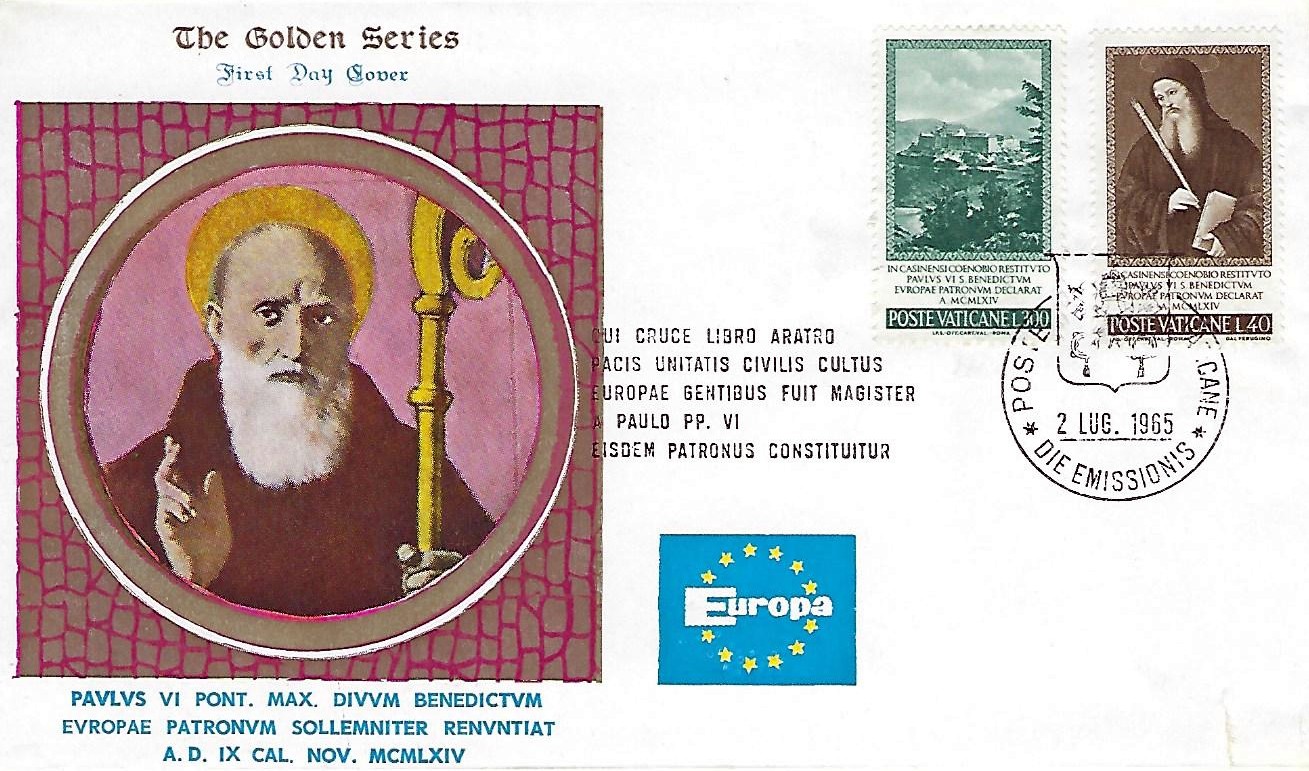
Home


St. Benedict (ca. 480-547/550) composed his monastic Rule after 529 when he relocated to Monte Cassino to establish the famous monastery, located 80 miles (130 km) southeast from Rome, on a high plateau overlooking a broad plain. Benedictine Monasticism spread throughout Europe and is one of the especially important factors influencing the development of ‘Europe.’ St. Benedict is considered the ‘Patriarch of Western Monasticism.’ He was named Patron of Europe by St. Paul VI in 1964 and, along with Ss. Cyril and Methodius, were named Co-Patrons of Europe by St. John Paul II in 1980 on the 1,500th anniversary of Benedict’s birth. For a person so important in Church History, little specific is known about St. Benedict and his dates are somewhat uncertain. The main somewhat contemporary source is the Dialogues of St. Gregory, the Great. He was born in Nursia, studied for a time in Rome, and at approximately age 14 he became a hermit at Subiaco in Lazio, near Tivoli, overlooking the River Aniene or Teverone (ca. 494). The Sacred Grotto (Sacro Speco) is a part of St. Benedict’s Abbey and the nearby Abbey of St. Scholastica, Benedict’s sister. He was invited to organize groups of hermits into a monastic foundation at Subiaco, occasionally meeting with resistance, including attempts on his life. In ca. 529 Benedict relocated to Monte Cassino where over time an abbey was built on a former Roman pagan site. The monks that gathered there were guided by The Rule of St. Benedict, a series of 73 chapters or precepts which directed monastic life, a path which was followed in other future European monasteries, and which eventually spread world-wide. The Rule sets down organizational principles, patterns of monastic life, roles and functions within a monastic community. In writing his Rule, St. Benedict states ‘…we intend to establish a school for the Lord’s service. In drawing on its regulations, we hope to set down nothing harsh, nothing burdensome.’ He admonishes monks that they ‘prefer nothing whatever to Christ, and may He bring us together in everlasting life.’ A principle of Benedictine hospitality is that ‘all guests…are to be welcomed as Christ.’ The principles of the Rule are adaptable to time and circumstance, even to our own day, adopted by laypeople as Benedictine Oblates, who follow the rule in daily, secular life. Monte Cassino, like many monasteries, experienced periods of vicissitude during its long existence. Allied planes bombed the abbey during World War II because German troops occupied the area and, after the bombing, occupied the ruins of the monastery. A bitterly fought assault by Free Polish brigades finally won the day for the allied forces. The abbey’s treasures and documents were evacuated to Rome before its destruction. Monte Cassino was restored after the war and rededicated by Paul VI. Portions of its buildings and grounds are open to visitors by schedule. St. Benedict’s reputed tomb is located behind the high altar of the Abbey, said also to contain the relics of his sister, St. Scholastica, the founder of an order of sisters who follow the Rule of St. Benedict. Another tradition holds that these relics (or some of them) were transferred to France (in ca. 673) during years that Monte Cassino had been abandoned following a 580 Lombard sack of the monastery. St. Benedict and/or St. Scholastica have been depicted not only on Vatican City stamps but by San Marino, Italy, Austria, and Italy. The Benedictine abbey at Subiaco was severely damaged by an earthquake on 30 October 2016. During a 2008 Wednesday audience, Pope Benedict XVI stated that Benedict contributed ‘a fundamental influence on the development of European civilization and culture. …[Benedict’s life and Rule]…were to prove heralds of an authentic spiritual leaven, which in the course of centuries, far beyond the boundaries of his country and time, changed the face of Europe following the fall of the political unity created by the Roman Empire, inspiring a new spiritual and cultural unity, that of the Christian faith shared by the peoples of the Continent. This is how the reality we call ‘Europe” came into being.’
• Pope Benedict XVI, ‘St. Benedict of Nursia,’ General Audience, 9 April, 2008 in Church Fathers and Teachers, from Saint Leo the Great to Peter Lombard • Dom Aelared Sillem, “St. Benedict,” in David Hugh Farmer, ed., Benedict’s Disciples • The Rule of St. Benedict in English, ed. Timothy Fry OSB, et. al. • St. Benedict’s entry in the Catholic Encyclopedia Article Links: • James C Hamilton, "St Benedict: From Subiaco to Monte Cassino to Patron of Europe:" Vatican Notes, Vol. 60, No. 351, pp. 11-18 (2012) | ||||||||
